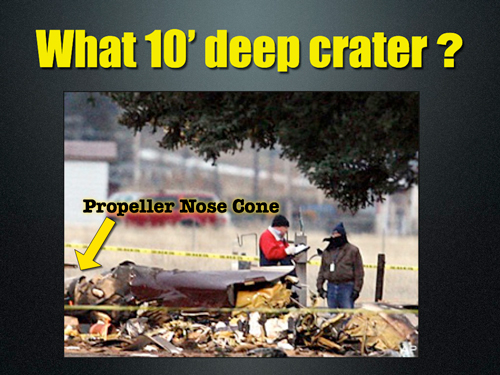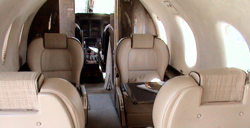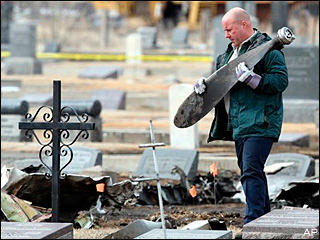Changed flight plan still a mystery as investigators probe deadly crash.
By Associated Press
BUTTE, Mont. (AP) – Half an hour before a small plane crashed in Montana, killing all 14 aboard, the pilot requested a change in course from Bozeman to Butte. Why he did that is emerging as a key mystery.

Our investigation leads to the following preliminary conclusions:
Eye witness Tom Hagler, reports that when the airplane stopped for fuel, he opened the restroom in his hanger for the passengers. Hagler reported that he saw a group of “about a dozen children and four adults Sunday morning” at the Oroville Municipal Airport, about 70 miles north of Sacramento. Hagler, owner of Table Mountain Aviation, described the children as ranging from about 6- to 10-year olds. He let the children into his building to use the restroom. “There were a lot of kids in the group,” he said. “A lot of really cute kids.”
The 10 foot deep crater: If the plane left a 10′ deep crater, why is the investigator in the the 3rd picture below walking off with a virtually unscathed propller blade? Seems to this aviation mechanic, that the prop was NOT spinning on impact, therefore we conclude that it is very likely the plane was overloaded and not carrying enough gas. With 17 people aboard, the plane’s fuel load was limited. Was the change in flight plans, a low on fuel diversion?
March 24, 2009—
Mark Rosenker, acting chairman of the NTSB, said Monday that the agency would calculate the weight of the luggage, fuel and passengers.
“Lap children can be allowed on an aircraft up to the age of 2,” Rosenker said. “We can’t tell you if in fact they were sitting on the laps or not.” [the plane only has TEN seats total!!!!]
 Investigators said they have no reason to believe the plane ran out of fuel or had mechanical problems.
Investigators said they have no reason to believe the plane ran out of fuel or had mechanical problems.
Witnesses who saw the plane overhead immediately knew something was terribly wrong.
“I heard the engine, and I look up to see it spinning and going into a nose dive,” Kenny Gulick, who witnessed the crash, told “Good Morning America.” “It was spinning. Normally, it would be at 90 degrees. It was at 180 degrees. … The pitch of the nose tried to move up slowly, but it was too close to the ground.”
Butte residents Steve and Martha Guidoni and her husband raced to the scene when they witnessed the plane spiral down. Moments later, it crashed straight into the ground.
“It came in the wrong angle and it was pretty low and then it was like something stopped midair, and it went boom,” Martha Guidoni told ABC News. “I could not fathom seeing what I’ve seen. I just kept telling him, it’s too unreal to be real. … It looked like a meteorite hit the ground. … I’ve never seen anything so scary in my life.”

The plane crash left a 10-foot deep crater at the cemetery. At the fiery wreckage, Steve hoped he would find a miracle, but he didn’t see it.
ABC News’ Lisa Fletcher contributed to this report.
Change in flight plan still a mystery as investigators probe deadly crash 

A worker carries a piece of propeller as NTSB investigators and local authorities scour the scene at Holy Cross Cemetery, scene of the fatal plane crash which killed 14 people.
By Associated Press
BUTTE, Mont. (AP) – Half an hour before a small plane crashed in Montana, killing all 14 aboard, the pilot requested a change in course from Bozeman to Butte. Why he did that is emerging as a key mystery.
Flying at 25,000 feet, pilot Buddy Summerfield requested the diversion shortly before the single-engine Pilatus PC-12 crashed at the edge of Butte’s airport Sunday about 75 miles away from Bozeman.
National Transportation Safety Board acting Chairman Mark Rosenker said finding out why the plane diverted is at the forefront of his agency’s investigation.
“It begins with that question – the 25,000-foot diversion to go to Butte,” Rosenker said.
Summerfield said nothing to controllers to indicate he was having trouble, and did not say why he was changing course from Bozeman to Butte.
The probe into the crash will include a review of Summerfield’s medical history, based on speculation that a heart attack or other health issue might have been at fault. Rosenker said air traffic controllers detected no strain in the 65-year-old pilot’s voice during his final communications.
Rosenker also revealed that the plane’s landing gear was down but its wing flaps were up at the time of the crash. That’s unusual for a landing aircraft but not unheard of, said the investigator in charge of the accident, Dennis Hogenson.
Also under scrutiny are weather conditions that could have caused icing on the plane’s wings and possible overloading. The plane was configured to seat just 10 people, but the fact that several of the 14 passengers were small children has dampened speculation that excess weight was a factor.
The investigation has been hampered by the lack of a cockpit voice recorder or data recorder, which were not required on the private flight. Rosenker said his agency may subpoena cell phone records of the victims to see if they could provide further clues.
While descending toward Butte’s Bert Mooney Airport, the plane passed through a layer of air at about 1,500 feet that was conducive to icing because the temperature was below freezing and the air “had 100 percent relative humidity or was saturated,” according to AccuWeather, a forecasting service in State College, Pa.
Safety experts said similar icing conditions existed when a Continental Airlines twin-engine turboprop crashed into a home near Buffalo Niagara International Airport last month, killing 50.
A possible stall created by ice – and the pilot’s reaction to it – has been the focus of the Buffalo investigation, which remains open.
NTSB spokesman Keith Holloway said it was too early to single out any one factor in the Butte crash.
“We’re looking at mechanical issues. We’re looking at weather. We’re looking at the structure of the aircraft. We’re looking at human performance, weight and balance issues,” Holloway said.








